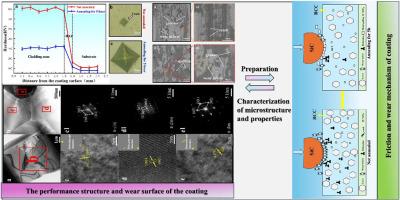热处理对激光熔覆VTiNbCrFeSi0.2难熔高熵合金涂层摩擦学性能的影响
IF 4.8
2区 材料科学
Q2 CHEMISTRY, PHYSICAL
引用次数: 0
摘要
本文采用激光熔覆技术制备了VTiNbCrFeSi0.2 HEA涂层,并在1200℃下退火5 h,研究了热处理对涂层的相组成、显微组织和耐磨性的影响。结果表明:VTiNbCrFeSi0.2涂层由BCC相、fe2nb型Laves相和枝晶NbTi4相组成;退火5h后,BCC相含量增加,fe2nb型Laves相含量减少。此外,退火后涂层中的晶格畸变也减小了。退火前后涂层的硬度较基体有明显提高。退火前涂层的平均显微硬度为790 HV,比基体高近3.13倍;退火后涂层的平均显微硬度为409 HV,比基体高约1.64倍。退火前涂层的磨损机制为磨粒磨损。相比之下,退火后涂层中的晶格畸变减弱,导致涂层中的残余应力降低,Laves脆硬相含量减少,从而减少了磨损过程中硬质磨料颗粒和磨损碎屑对涂层的切削,导致摩擦系数降低,这使得退火后涂层的耐磨性高于退火前。退火后的涂层表现出粘着磨损和少量磨粒磨损的复合磨损机制。结果表明,热处理对涂层的组织和性能有显著影响,为耐火高熵合金在高温环境下的应用提供了理论依据。本文章由计算机程序翻译,如有差异,请以英文原文为准。

Effect of heat treatment on the tribological properties of laser-cladded VTiNbCrFeSi0.2 refractory high-entropy alloy coating
In this paper, VTiNbCrFeSi0.2 HEA coating was prepared by laser cladding technology and the prepared coating was annealed at 1200 °C for 5 h. The effects of the heat treatment on the phase composition, microstructure, and wear resistance of the coating were investigated. The results show that the VTiNbCrFeSi0.2 coating consists of the BCC phase, Fe2Nb-type Laves phase, and dendritic NbTi4 phase. After annealing for 5 h, the content of the BCC phase increases while the Fe2Nb-type Laves phase content decreases. Additionally, the lattice distortion in the coating is reduced after annealing. The hardness of the coating before and after annealing shows a significant improvement compared to the substrate. The average microhardness of the coating before annealing is 790 HV, nearly 3.13 times higher than that of the substrate, and after annealing, the average microhardness of the coating is 409 HV, about 1.64 times higher than that of the substrate. The coating's wear mechanism before annealing is abrasive wear. In contrast, after annealing, the lattice distortion in the coating is weakened, which leads to reduced residual stress in the coating and decreased content of the Laves brittle hard phase, which reduces the cutting of hard abrasive particles and wear debris on the coating during the wear process, resulting in the decrease of friction coefficient, which reasons make the wear resistance of the coating after annealing higher than that before annealing, and the coating after annealing shows a composite wear mechanism of adhesive wear and a small amount of abrasive wear. The results show that heat treatment has a significant effect on the microstructure and properties of the coating, which provides a theoretical basis for the application of the refractory high entropy alloy in high temperature environment.
求助全文
通过发布文献求助,成功后即可免费获取论文全文。
去求助
来源期刊

Intermetallics
工程技术-材料科学:综合
CiteScore
7.80
自引率
9.10%
发文量
291
审稿时长
37 days
期刊介绍:
This journal is a platform for publishing innovative research and overviews for advancing our understanding of the structure, property, and functionality of complex metallic alloys, including intermetallics, metallic glasses, and high entropy alloys.
The journal reports the science and engineering of metallic materials in the following aspects:
Theories and experiments which address the relationship between property and structure in all length scales.
Physical modeling and numerical simulations which provide a comprehensive understanding of experimental observations.
Stimulated methodologies to characterize the structure and chemistry of materials that correlate the properties.
Technological applications resulting from the understanding of property-structure relationship in materials.
Novel and cutting-edge results warranting rapid communication.
The journal also publishes special issues on selected topics and overviews by invitation only.
 求助内容:
求助内容: 应助结果提醒方式:
应助结果提醒方式:


